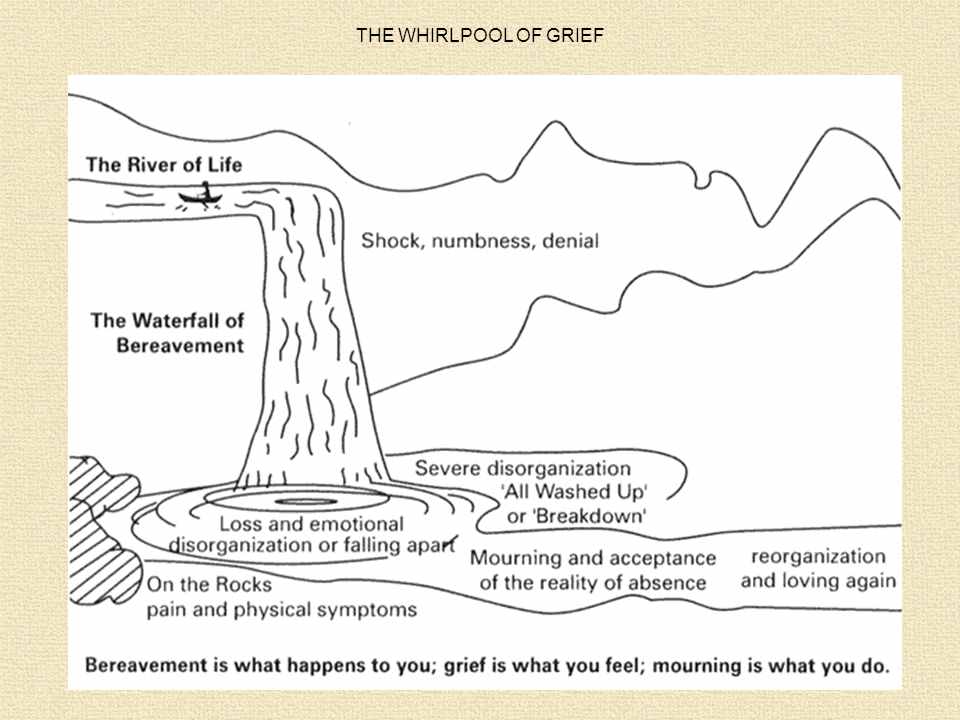Coping with loss and bereavement

Every time there is a significant change in our lives, such as loss and bereavement, we experience a range of feelings. It can be a confusing and frightening time. Understanding loss and bereavement can help with the grieving, and to understand what is happening. Coping with loss and bereavement is an important step forward.
The terms loss, bereavement, grief and mourning are explained below:
- If bereavement is what happens to you, grief is how you feel and react.
- If bereavement is a wound, grief is the inflammation that follows. It causes pain, swelling and disturbance of function. It can last a long time and may leave scars. However, it is the process by which healing occurs.
- Mourning is what you do. It is vital to have something to do, to have a ritual to follow so that there is a recognised role for everyone concerned. Mourning can help to allow reality to be faced. (Wilson R, 1993)
JOURNEY OF GRIEF
In her book ‘Through Grief – The Bereavement Journey’ Elizabeth Collick says “There is no way round grief, only a way through”. In other words there is no escape from it. Every bereaved individual needs to follow their own unique journey of grief. The only way to understand what the death means to someone is to allow them to share their feelings, experience and their needs. This can be done with
The actual death of someone close may be just one aspect of the difficulties of bereavement. It can be complicated or feel deeper from other factors. Such as person’s personality or background; their relationship with the dead person; the circumstances of the death/how they died; and the bereaved person’s recovery environment.
THE WHIRLPOOL OF GRIEF
A good way to understand the grief journey is explained by Dr Richard Wilson’s visual picture Whirlpool of grief’. The picture below shows an oarsman rowing along the ‘River of Life’. When they experience the death of someone who is close to them, they are plunged down the ‘Waterfall of Bereavement’ otherwise known as the ‘Whirlpool of Grief’.

“Coming down the waterfall represents a sudden disruption to one’s life, which may have been flowing along quite smoothly up to this point. It represents shock and numbness. The whirlpool represents the emotional upheaval and disorganisation that follows (anger, guilt, anxiety, etc.). being ‘all washed up’ on the banks of the river could represent ‘being stuck’ and unable to move on. Before being able to progress one would have to get back into the whirlpool and experience the emotional turmoil. With gradual acceptance of the loss, one would be able to move along the river of life again.”
THE TASKS OF GRIEVING or MOURNING
Professor William Worden (1991) stresses that mourning, which he defines as the emotional process that occurs after a loss, is an essential and necessarily painful healing process, which is achieved through a series of tasks.
‘Tasks of Mourning’
- To accept the reality of the loss
- To work through (experience) the pain of grief
- To adjust to the environment in which the deceased person is missing
- To emotionally relocate the deceased and move on with life
Facing Reality
When someone dies, even if the death is expected, there is often a sense that it hasn’t happened. This first task is to fully comprehend the reality that the person is dead, that they are gone and will not return. There is likely to be an initial state of shock and numbness, sometimes manifesting itself as uncontrollable crying/hysteria or the antithesis of displaying no emotion at all, appearing very controlled, calm or detached.
This initial shock may last several days (sometimes much longer) and usually allows the bereaved to deal with all the necessary practicalities and cope with the funeral without losing control – a form of emotional protection.
Some people may not immediately be able to acknowledge what has happened and may cope by denying it or refusing to talk about it. Being able to see the dead person, being involved as much as possible in the preparations for the funeral, and observing rituals and traditions, all assist people to face the reality of what has happened. Families from ethnic minorities may need permission and support for the mourning rituals appropriate to their culture.
Experiencing the pain of grief
As the numbed feeling gradually subsides and the reality of what has happened is experienced, the bereaved person may have intensely painful feelings, which may last weeks or months. Their grief may overwhelm them so that they are incapable of thinking about anything or anybody else but themselves and how they feel. It gets in the way of everything they think and do. They may overreact to other people’s comments and appear irritable.
As well as feeling extreme sadness, the bereaved often experience guilt, anger and resentment. Many people experience guilt with some aspect of their relationship with the dead person. Often people struggle with the things they have (or have not) said or done. Maybe they had not spent enough time with them or really listened.
Feelings of anger can be extremely powerful. The bereaved person may feel anger towards the dead person; anger for the loss of control that death brings; anger at the medical team for not curing the illness or keeping the dead person alive; and anger at God for letting it happen. They may feel resentment of a family member who they feel contributed in some way to the death.
Adjusting to the environment without the deceased person
The new reality of facing life without someone you love is a difficult and painful process. No one can fill the aching void the person has left and each day life brings constant reminders of their absence. The future seems uncertain or even frightening and a tremendous effort is required to get through every day. It may take many months before the bereaved person is able to dwell less on the sad events surrounding the death and starts to function more as they did before the loss.
Reinvesting in the future
This involves moving on to a new way of life without the dead person, whilst holding on to memories. It is a way of reinvesting in life again alongside the knowledge that the dead person will never be forgotten. This can often feel like a betrayal and is perhaps the most difficult task of all.
The bereaved are able to:-
Have a sense of resurrection
- Put their sadness aside
- Look to the future, whilst recalling happy times spent with the person who has died
- Find comfort and pleasure in their memories.
- Life becomes more meaningful and they regain a sense of control
It is normal at anniversaries for feelings of grief to be aroused again and to be as vivid as on the day the death occurred but this settles more quickly and becomes less painful.
Grief is not a mental illness, although sleeplessness, anxiety, fear, anger and a preoccupation with self can all add up to a feeling of ‘going mad’. These feelings are natural and when experienced and expressed will become less frequent and begin to subside over time. Talking about them and bringing them into the open is helpful. Expressing grief is cathartic and attempts to short circuit these feelings rarely help in the long term and may cause deep seated problems in the years ahead. If grief is denied, or anger and guilt persist to the exclusion of other feelings, counselling can help to address these issues.
Another way to understand grief is through the five stages of grief. This is explained in a later blog post.
Other posts talking about loss and bereavement are:
Painful place called Bereavement
Six Steps to dealing with bereavement
Pingback: absent father
Pingback: Dealing with loss or bereavment - Counselling in your Community